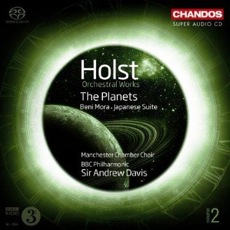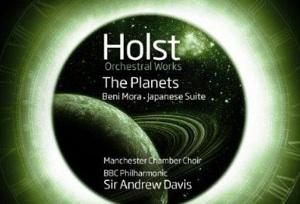
Sir Andrew Davis
More than twice as many recordings of The Planets are available as there are moons in the solar system — so what makes Sir Andrew Davis’ new CD so special?
It’s not the performance of Gustav Holst’s most famous work, unfortunately. Davis’ interpretation, while adequate, just has too much superior competition out there, such as the performances of Dutoit, Von Karajan, and Boult. What does recommend this Chandos release are the superb sonics, with a huge dynamic range (not ideal for car stereos, what with the outside noise). Plus, there are 28 minutes’ worth of two rarely heard works of the composer, Beni Mora and the Japanese Suite.
Beni Mora was completed in 1910, less than four years before Holst began his first planet, “Mars,” and it displays many of the characteristics that appeal in the later suite. Foremost among these are the atmospheric orchestrations and the inventive handling of obsessively repetitive figures. The music was inspired by a visit to Morocco that Holst undertook in 1908, which included a bicycle tour in the Sahara. Consisting of two dances and a finale, “In the street Ouled Nais,” the music has some pleasant moments and scattered Orientalisms.
Listen To The Music
Mars ClimaxBeni Mora--First Dance
Purchase Recording


A portion of each purchase helps
support San Francisco Classical Voice
The Japanese Suiteis no more Japanese than Beni Mora is Moroccan, though it offers a little more subtlety. Listen, for example, to the charming orchestration of its third number, “Dance of the Marionette.” However, neither this suite nor Beni Mora is an undiscovered masterpiece that should necessarily be snatched up. For suites in that category, check out those by the Norwegian composer Geirr Tveitt.
The meat of the release, second-tier though it is, deserves comment. As in many “sound spectacular” works, engineers enjoy goosing the sound of this music so that what you get is not necessarily what you’d hear in the concert hall. The goosing in this recording is in excellent taste and is particularly effective in its handling of the organ sound 19 bars before the end of “Mars.” Here, Davis takes an extra ritardando, as well, resulting in one of the most effective climaxes of this movement I’ve heard. Unfortunately, he follows this one bit of inspiration with a thoroughly pedestrian account of the remaining bars, compared to Boult’s or Karajan’s versions.
With one exception, Davis’ interpretations of the rest of the movements are quite good. That exception is what Holst himself called his favorite movement, “Saturn, the Bringer of Old Age.” Davis apparently thinks the Bringer is a fast friend of Mercury. For my taste, a more scarily inevitable and ponderous approach is required in this meditation on death, written in the midst of the appalling catastrophe of World War I.
To sum up, if it’s excellent sound you’re after, plus some unusual lesser music of the “other Gustav,” this Chandos CD is worth a few listens. But don’t let this be your only Planets recording.
(By the way, if you’re still wondering about the satellitic content of the solar system, there are 166 of them.)

